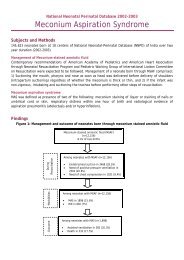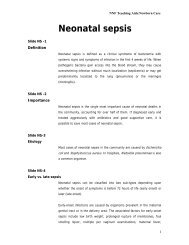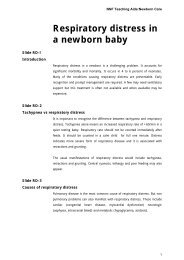Hypoglycemia in the newborn period - New Born Baby
Hypoglycemia in the newborn period - New Born Baby
Hypoglycemia in the newborn period - New Born Baby
You also want an ePaper? Increase the reach of your titles
YUMPU automatically turns print PDFs into web optimized ePapers that Google loves.
AIIMS- NICU protocols updated 2007<br />
mg/dl after 24 hours of parentral <strong>the</strong>rapy, <strong>the</strong> <strong>in</strong>fusion can be tapered off at <strong>the</strong> rate of 2<br />
mg/kg/m<strong>in</strong> every 6 hours, with glucose monitor<strong>in</strong>g. Taper<strong>in</strong>g has to be accompanied by<br />
concomitant <strong>in</strong>crease <strong>in</strong> oral feeds. Once a rate of 4 mg/kg/m<strong>in</strong> of glucose <strong>in</strong>fusion is reached<br />
and oral <strong>in</strong>take is adequate and <strong>the</strong> blood sugar values are consistently > 50 mg/dL <strong>the</strong> <strong>in</strong>fusion<br />
can be stopped without fur<strong>the</strong>r taper<strong>in</strong>g. Ensure cont<strong>in</strong>uous glucose <strong>in</strong>fusion without any<br />
<strong>in</strong>terruption preferably us<strong>in</strong>g <strong>in</strong>fusion pump.<br />
Do not stop an IV <strong>in</strong>fusion of glucose abruptly; severe rebound hypoglycemia may occur. Avoid<br />
us<strong>in</strong>g > 12.5% dextrose <strong>in</strong>fusion through a peripheral ve<strong>in</strong> due to <strong>the</strong> risk of thrombophlebitis<br />
Recurrent / resistant hypoglycemia<br />
This condition should be considered when <strong>the</strong>re is a failure to ma<strong>in</strong>ta<strong>in</strong> normal blood sugar<br />
levels despite a glucose <strong>in</strong>fusion of 12 mg/kg/m<strong>in</strong> or when stabilization is not achieved by 7<br />
days of life. High levels of glucose <strong>in</strong>fusion may be needed <strong>in</strong> <strong>the</strong> <strong>in</strong>fants to achieve euglycemia.<br />
Table no 4 : Important causes of resistant hypoglycemia and <strong>in</strong>vestigations<br />
Important causes of resistant hypoglycemia Investigations to be considered<br />
Congenital hypopitutarism<br />
Serum <strong>in</strong>sul<strong>in</strong> levels<br />
Adrenal <strong>in</strong>sufficiency<br />
Hyper<strong>in</strong>sulenemic states<br />
Galactosemia<br />
Glycogen storage disorders<br />
Maple syrup ur<strong>in</strong>e disease<br />
Mitochondrial disorders<br />
Serum cortisol levels<br />
Growth hormone levels<br />
Blood ammonia<br />
Blood lactate levels<br />
Ur<strong>in</strong>e ketones and reduc<strong>in</strong>g substances<br />
Ur<strong>in</strong>e and sugar am<strong>in</strong>oacidogram<br />
Besides <strong>in</strong>creas<strong>in</strong>g <strong>the</strong> rate of glucose <strong>in</strong>fusion, drugs may also be tried <strong>in</strong> <strong>the</strong> treatment of<br />
resistant hypoglycemia. Before adm<strong>in</strong>istration of <strong>the</strong> drugs , take <strong>the</strong> samples to <strong>in</strong>vestigate <strong>the</strong><br />
cause (Table no 3) . Drugs that are used <strong>in</strong>clude <strong>the</strong> follow<strong>in</strong>g:<br />
Downloaded from www.<strong>newborn</strong>whocc.org<br />
8








